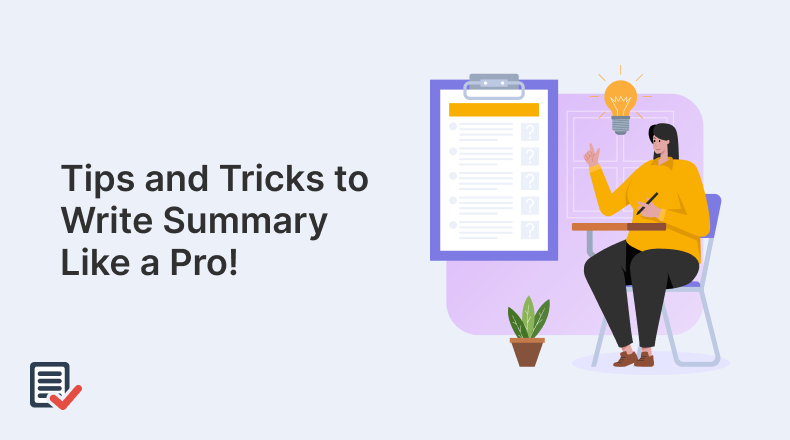
Whether you are a student, writer, content creator, or even business professional, you must learn the art of summarization. This capability helps you shorten the whole content in an effective way that conveys the same message as the longer one delivers. A well-written summary provides the readers with only the information that they need to know.
Well, writing a summary is not everyone’s cup of tea. Summarizing content in an efficacious way is not as easy as it sounds. You have to be strategic and familiar with key practices that make you able to write a well-crafted summary.
In this article, we will provide you with some practical tips that will significantly transform the way you summarize text.
1: Understand The Purpose
If you aim to write an effective summary, it should be clear in your mind why you are writing it. You might need to craft summaries for different purposes. So, ask yourself: Are you summarizing to provide an overview, to analyze and critique the text, or to extract specific information for reference?
Prioritizing your goal will help you decide what to exclude and what to include in your summary. This will enable you to end up writing a summary that exactly matches the objective you set before writing.
2: Carefully Read the Whole Text
Writing a persuasive summary starts with a careful reading of the content. You cannot succeed in creating a valuable summary if you undermine reading. So, before putting your hands on the keyboard or picking up your pen, first read the entire text attentively.
While reading, make sure you don’t skip any part of the content because you might miss some crucial details. Reading text closely smoothens your journey and sets you on the path to writing a compelling summary.
3: Identify The Main Idea
The summary is all about finding and crafting the main idea or central message of in-depth content. Therefore, while reviewing the text, discover what it is mainly about and what it covers the most.
Don’t get limited to one-time study. Rather, keep examining the content again and again until you grasp the core of the theme. While exploring the content you want to summarize, highlight the main points and note them down. This will help you remember to include them while summarizing the content.
4: Stay To The Point
A good summary includes only the essential information. Remember, summary writing is not like describing the same content in detail. Rather, it is the art of presenting thorough information briefly.
Therefore, while creating a summary, ensure that you focus only on core details. Avoid elaborating on things unnecessarily, and try to sum up them in fewer words. The details that don’t contribute to the main message make the summary less effective. So, refrain from including excessive details and stay to the point.
5: Follow A Logical Structure
Compressing the information doesn’t mean that you put details wherever you want. For example, if a point is discussed at the start of reference content, it should not be placed at the end of the summary.
The irregular arrangement of information makes the summary vague and less comprehensible for readers. Therefore, make sure that you order the details in a logical flow that makes sense. For this purpose, you can use transition words to connect and order the information in the right way.
6: Avoid Repetition
Sometimes, the writer discusses the same thing in different parts of the content in distinct ways. You might get confused when recognizing whether you have already read a point or not. This confusion causes you to include a single point multiple times in the summary, creating repetition.
It reduces the room for essential information to be included in the summary. Therefore, be mindful of what you write so that you can avoid redundancy in information and ensure variety in summary.
7: Use Your Own Words
Summarizing is not replicating the main points from the original text. Rather, it is a practice of concising already existing information uniquely. Therefore, don’t copy-paste the exact words from the content to be summarized. Rather, summarize it in your own words to make it distinct and more valued.
Try to express the same information from different angles to ensure uniqueness in summary. This demonstrates your understanding of the material and helps prevent plagiarism.
8: Check For Accuracy
Accuracy is the key pillar of writing. Summaries having informational or lingual flaws not only affect your reputation but also hinder readers from reading. Therefore, confirms that your summary doesn’t contain any type of mistakes that can lower its effectiveness.
Double-check to ensure that you have accurately represented the original text. Also, verify that the whole text is free from grammatical errors like spelling mistakes, missing or inaccurate punctuation, etc.
9: Review And Edit
Summary writing ends with proper proofreading and editing. This is the last but most important step in summarizing content. It helps you identify and eliminate mistakes you make unintentionally.
While performing the final review of your summary, pay close attention to each sentence to ensure that it is flawless. Recheck for typos, uniqueness, and informational accuracy. Make sure that the whole summary follows a flow and doesn’t contain irregular details that might bother readers.
To Sum Up:
In short, summary writing expertise enables you to wrap the essence of lengthy content in a nutshell. Being able to effectively summarize text helps you shortly deliver nearly the same information as the full-length content conveys.
However, summary writing can not be done efficiently if you are unaware of the proper way to write it. Keeping your needs in mind, we have listed above the most working tips that make you a proficient summary writer. So, we hope you will implement those suggestions when writing your next summary.







